NRAO eNews
Volume Vol#, Issue Iss#
Day# Month# Year#
NRAO eNews
Volume Vol#, Issue Iss# • Day# Month# Year#

Upcoming Events

NRAO Science & Development Webinar
9:30 - 10:00 a.m. PDT, Jun 13, 2022 | Pasadena, CA

Addressing the Impact of Satellite Constellations on Astronomy: The Pathway Forward
1:00 - 3:00 p.m. PDT, Jun 13, 2022 | Pasadena, CA

NRAO Town Hall
6:30 - 8:00 p.m. PDT, Jun 13, 2022 | Pasadena, CA

AAS Splinter Session: A Bold Future for Astrophysics
9:00 - 10:30 a.m. PDT, Jun 15, 2022 | Pasadena, CA

Community Webinar Series: VLA Science Ready Data Products
Jun 23, 2022 | Virtual

The VLA Sky Survey in the Multiwavelength Spotlight
Sep 7 - 9, 2022 | Socorro, NM

From Cells to Galaxies: Exploring the Synergies between Radio Astronomy & Medical Imaging
Sep 21 - 23, 2022 | St. Paul, MN

9th VLA Data Reduction Workshop
Oct 11 - 20, 2022 | Socorro, NM
Semester 2022B Telescope Time Allocation

The NRAO has completed the Semester 2022B proposal review and time allocation process for the Very Large Array (VLA) and the Very Long Baseline Array (VLBA).
For the VLA, the C-configuration will be available in the 22B semester and 126 new proposals were received by the 1 February 2022 submission deadline, including two large and twenty-two time critical (triggered) proposals. The oversubscription rate (by proposal number) was 2.6 and the proposal pressure (hours requested over hours available) was 2.1, both of which are similar to recent semesters.
For the VLBA, 34 new proposals were submitted. The oversubscription rate was 1.6 and the proposal pressure was 1.6, lower than the past few semesters but not unprecedented for the VLBA.
There was some demand for the time made available on space observatories through inter-observatory agreements, and seven proposals requesting time on HST, Swift, or XMM-Newton (together with AUI/NRAO telescope time) were submitted.
Proposals submitted to the Green Bank Observatory (GBO) were assessed through the same process. Sixty-one proposals for the Green Bank Telescope (GBT) were received for the 22B Semester. The oversubscription rate is 2.3 and the proposal pressure is 1.8. For information on proposals for GBT observations see the GBO website.
The proposals were reviewed for scientific merit by nine Science Review Panels (SRPs) and for technical feasibility by NRAO staff. These reviews were completed in February – March 2022 and then considered by the Time Allocation Committee (TAC) during a remote meeting on 25-26 April 2022. The TAC – comprising the 9 SRP chairs – was charged with recommending a science program for Semester 2022B to the Observatory Director. The recommended program was reviewed and approved on 11 May 2022.
A disposition letter was sent to the Principal Investigator and Co-Investigators of each proposal on 20 May 2022 and a TAC report containing information for proposers and observers, including statistics and telescope pressure plots, was released the same day. The approved science program for the VLA and the VLBA has been posted to the NRAO science website. The authors, title, abstract, and scheduled hours for each approved proposal can be accessed from the Proposal Finding Tool.
The Student Observing Support program continues to be available for NRAO observing programs and we encourage Principal Investigators of highly-ranked VLA and VLBA proposals to consider applying for support.
The NRAO welcomes community feedback on the proposal review and time allocation process. Please provide such feedback via the Proposal Review department of the NRAO Helpdesk.
ALMA Program News
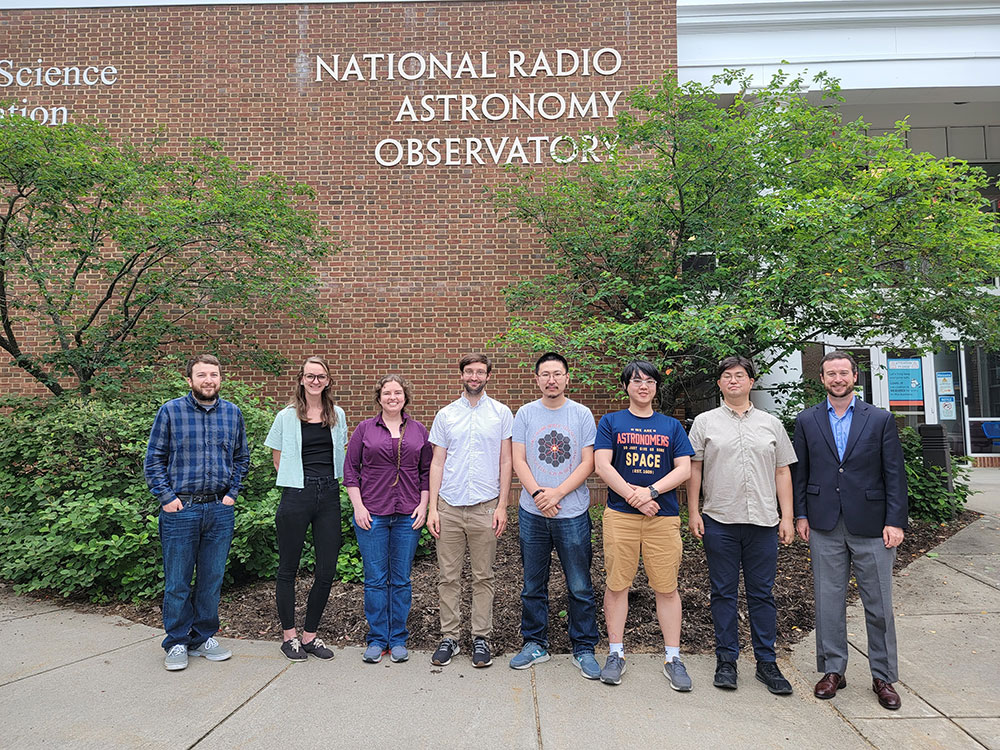
Cycle 9 ALMA Ambassadors Nathan Roth (U. Md.), Hayley Roberts (U. Colorado), Allison Towner (U. Fl.), Charles Law (Harvard) , Fengwu Sun (U. Arizona), Cheng-Han Hsieh (Yale), Hansung Gim (U.Montana). George Privon (NAASC) on far right. Not shown - Wren Suess (UC Santa Cruz) and Tarraneh Eftekhari (Northwestern)
[click to enlarge]
Cycle 8 Science Operations
ALMA will shortly move from its current C4 to the C5 Cycle 8 configuration as scheduled in the last third of June, to be followed by configuration C6. In C4 configuration, baseline lengths in the 12m array span 15-784m, for a main beam size at 3mm of 0.92 arcsec. Weather has been good with daily subfreezing temperatures, as is normal for May/June.
The process of refereeing and selecting Cycle 9 proposals has begun. Results will be available in August 2022. Cycle 9 is currently scheduled for observations from October 2022 to September 2023.
ALMA Science Sustainability
A Call for Proposals for ALMA Development Studies was released 9 May 2022.
An optional informational webinar with question/answer period was held on 7 June 2022. See the Call for Study Proposals Webpage for Coordination meeting materials.
The deadline for proposals is 12 July 2022 for funding to run 1 January–1 December 2023, depending on the U.S. Federal budget process.
We welcome any member from within the North America ALMA Development Partnership to submit a proposal to investigate a potential ALMA upgrade (hardware, software, or advanced techniques). Particular attention should be given to ideas which may address the goals elucidated in The ALMA Development Roadmap, ALMA Memo 612. Proposers MUST submit a Study Proposal Notice Of Intent by 14 June 2022.
ALMA Ambassadors Visit the NAASC
Seven of the Cycle 9 ALMA Ambassadors visited the North American ALMA Science Center (NAASC) in Charlottesville the week of 23 May to showcase their science. In addition to a science poster session and reception, the Ambassadors met with NAASC staff, received mentoring and training in proposal reviews, and presented their latest scientific results to several local scientific discussion groups. The Cycle 9 Ambassadors will lead workshops focused on ALMA data processing. These events will be announced via the NRAO eNews in the Fall.
Interested in being an ALMA Ambassadors for Cycle 10? Visit the ALMA Ambassadors page for more information about the program. Applications for Cycle 10 will open later in the summer.
ngVLA Project News
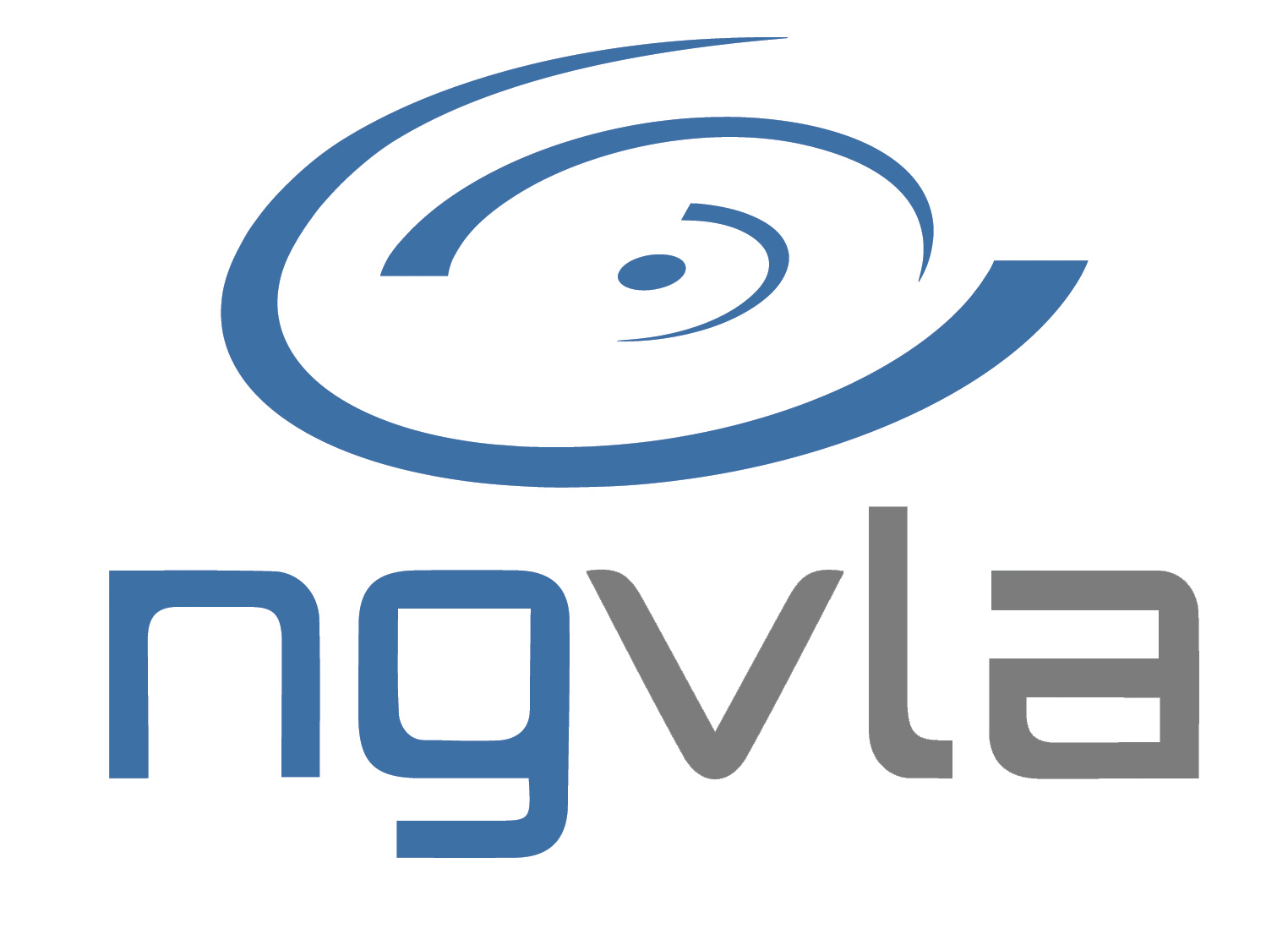
AAS Splinter Session: A Bold Future for Astrophysics
Astronomy is on the threshold of a knowledge revolution, led in no small part by the imminent revolution in ground-based facilities, including the next-generation Very Large Array (ngVLA). Join us at the American Astronomical Society’s meeting in Pasadena, California from 9:00 a.m. to 10:30 a.m. Pacific Daylight Time on Wednesday, 15 June 2022, for a Splinter Session designed to deepen the vision for a vibrant U.S. astrophysics future based on science laid out by Astro2020.
Spectral Distortions of the Cosmic Microwave Background
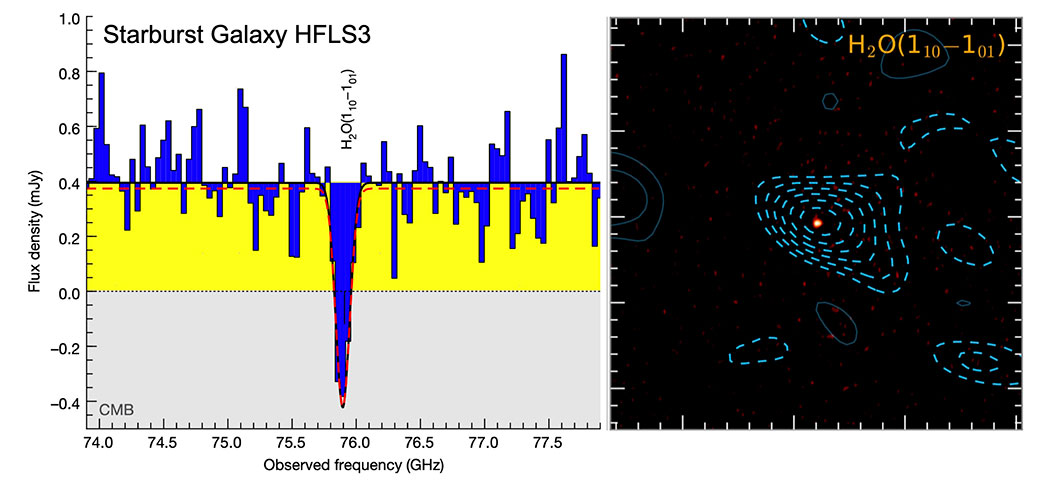
Frequency spectrum (left) and map (right) of the redshifted H2O absorption observed toward the starburst HFLS3 with NOEMA. Yellow histogram is the starburst dust continuum emission, toward which the H2O absorption (blue histogram and dashed contours) is observed. Credit: Riechers et al. 2022.
[click to enlarge]
Distortions of the Cosmic Microwave Background (CMB) can be utilized to constrain fundamental cosmological parameters associated with the expansion of the Universe. Since the CMB is considerably warmer at earlier cosmic epochs, it can also increasingly change the properties of the interstellar gas and dust associated with galaxies. As such, galaxies with the same intrinsic properties can appear different in the early Universe compared to the present day, because the CMB can act on them as an extra heating source. Concurrently, the interaction of the CMB with the interstellar gas can locally distort the appearance of the CMB.
A new kind of such a distortion was recently observed toward the starburst galaxy HFLS3, which existed only 880 million years after the Big Bang (Riechers et al. 2022). At its epoch, the CMB was more than seven times warmer than its 2.7 K at present day–sufficient to excite the lower rotational transitions of H2O in the galaxy's cold interstellar gas. At the same time, the energy released by the starburst acts as another heating source, which can alter the "base" H2O excitation provided by the CMB. In combination, this causes a net deficit of H2O molecules in the first excited state compared to the ground state. The transition between these states, occuring at 557 GHz in the rest frame, can thus be seen in absorption against the CMB (see figure).
If the starburst properties are known, the depth of the absorption only depends on the CMB temperature at the starburst's epoch, and can therefore be directly measured from this distortion. The HFLS3 measurement is consistent with the 20 K temperature expected in standard LambdaCDM cosmology, and thus does not require any more exotic prescription for the properties of dark energy or other fundamental cosmological parameters. However, these findings are currently based on a single measurement.
While more detections of this effect at different epochs are possible in principle, the expected signals are sufficiently faint toward the brightest available targets to require long integration times on the best current millimeter-wave interferometers. Also, to fundamentally decrease the existing uncertainties, it would be necessary to map the H2O absorption at high spatial resolution, which is largely beyond the capabilities of current facilities. The required order-of-magnitude improvement to detect the signal toward more typical galaxies and to map it in bright sources requires a major leap in sensitivity, which will likely only become available once the ngVLA is fully operational.
Since 2015 the acronym ngVLA has appeared in 800+ publications indexed in the SAO/NASA Astrophysics Data System. This article continues a regular feature intended to showcase some of those publications. We are especially interested in showcasing work done by early-career researchers. The collection of showcase articles can be viewed online. Anyone wishing to volunteer to author a feature should contact Joan Wrobel.
The VLA Sky Survey in the Multiwavelength Spotlight
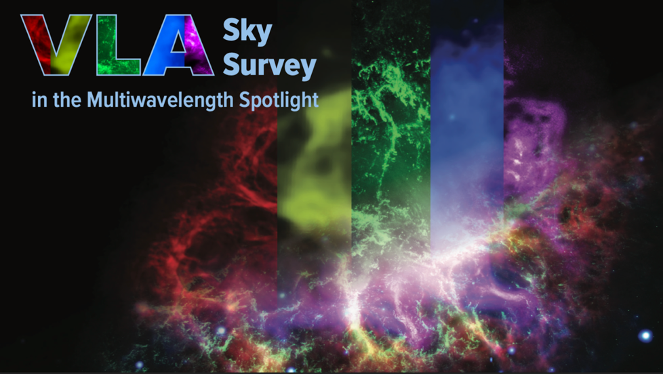
The “Very Large Array Sky Survey in the Multiwavelength Spotlight” conference will take place 7-9 September 2022! The hybrid format of this NRAO-sponsored conference will allow participants to choose to attend either in-person in Socorro, NM, or virtually on Zoom.
Conference Goal: The main goal of this conference is to share diverse scientific perspectives, both on the discoveries enabled by the Very Large Array Sky Survey (VLASS) on its own, and on advances made possible with other datasets. Opportunities for multiwavelength synergy include radio/mm observations (e.g., ALMA, LOFAR, ASKAP, MeerKAT, Apertif), optical/infrared imaging and spectroscopy (e.g., HST, Roman, Euclid, DESI, PFS, JWST), multi-epoch widefield surveys (e.g., SDSS, PanSTARRS, LSST, DES, ZTF), and the high-energy domain (e.g., Chandra, XMM-Newton, eROSITA).
A Conference for the Entire Community: VLASS originated as a community-driven initiative to carry out a synoptic radio survey using the Karl G. Jansky Very Large Array (VLA). The survey was designed to engage radio astronomy experts, multi-wavelength astronomers, and the broader community alike. Prior experience with VLASS or radio interferometry is NOT required to attend the VLASS conference. We encourage diverse and creative abstracts. Anyone who would like to learn more about VLASS is encouraged to attend! The conference will include demonstrations on accessing VLASS data to use it for science.
Program Highlights: Beyond science, the program will include a special talk tailored to the VLASS conference by Astrophysicist/Folklorist/Author Dr. Moiya McTier on diversity in astrophysics! There will also be interactive panel discussions on both science and broadening participation, tutorials on VLASS data products and tools, an in-person tour of the VLA including an antenna climb, and much more!
Oral abstracts due on June 16: We are soliciting abstracts for both oral and poster presentations related to the following topics. Submit your abstract today!
- Galaxies, SMBHs, AGN, and quasars
- Explosions, variables, and transients
- Star formation and the ISM
- Galactic radio sources
- Polarimetry and Magnetism
- Broadening participation in astronomy*
- Multiwavelength surveys and instruments
- Data products, archives, and tools
(*Broadening participation topics include student programs, mentoring, and outreach.)
Registration: Register today! The registration deadline is 1 August 2022 for in-person and virtual attendance. Discounted student rates are available.
Regular Science Sessions:
- Dillon Dong (Caltech) - Radio Transients
- Raffaella Margutti (UC Berkeley) - Multiwavelength Time Domain
- Sinclaire Manning (UMass Amherst) - Galaxy Evolution/Observations
- Rachel Osten (STScI) - Galactic Science
- Tessa Vernstrom (CSIRO) - Cosmic Magnetism
- Mubela Mutale (University of Leeds) - Compact Galactic plane sources
- Claudia Lagos (ICRAR) - Galaxy Evolution/Theory & Modeling
- Jenny Greene (Princeton) - Supermassive Black Holes
- Sjoert van Velzen (Leiden) - Tidal Disruption Events
- Beatriz Mingo (The Open University) - Active Galactic Nuclei
Interactive Panel Sessions: In addition to regular science sessions, the conference program will include three 90-minute “panel sessions.” Each one will consist of a series of back-to-back 15-minute talks followed by an interactive 30-minute group discussion. The chair(s) of each panel session will provide questions in advance. The goal is to facilitate a productive and creative conversation during the live sessions as well as before/after the conference on Slack. Panel sessions and confirmed invited speakers are listed below:
1) Multiwavelength Surveys and Instruments
- Shobita Satyapal (George Mason University) - Optical/Infrared
- Andreea Petric (STScI) - Spectroscopic Surveys
- Anna Ho (UC Berkeley) - Multiwavelength Time Domain
- David Alexander (Durham University) – X-ray/High-energy
2) Next-generation Radio Instruments and Techniques
- Casey Law (Caltech) - Rapid Radio Time Domain with REALFAST
- Wendy Peters (NRL) - The VLITE Commensal Sky Survey
- Joe Callingham (Leiden University) - SKA pathfinders and precursors
- Leah Morabito (Durham University) - VLBI with LOFAR
3) Broadening Participation
- Brian Kent (NRAO) - Data discovery with VLASS and the NRAO NINE Program
- Jennifer Bates (NRAO) - RADIAL
- Jillian Bellovary (AMNH) - CUNY’s New Astrophysics Masters Program
Meet the Survey:
- Amy Kimball (NRAO) - VLASS Overview
- Shami Chatterjee (Cornell) - VLASS Science Highlights
- Danielle Rowland (NRAO) - NRAO Office of Diversity and Inclusion Programs
- Steve Myers (NRAO) - VLASS Data Products
- Greg Sivakoff (U. of Alberta) - CIRADA
- Mark Lacy (NRAO) - VO Tools
Special Session on Diversity in Astronomy: Moiya McTier (Media Moiya LLC) - “A Galaxy Needs All Kinds of Stars.” Dr. Moiya McTier is an astrophysicist/folklorist/author and science communication expert. She is also an alumnus of NRAO’s National Astronomy Consortium (NAC) program, and a long-standing peer-mentor and role model. During the conference, Moiya will be offering guidance sessions for early-career participants on topics such as poster/talk preparation. Stay tuned for additional details! Participants will also have an opportunity to purchase an autographed copy of Moiya's new book, “The Milky Way: An Autobiography of Our Galaxy.”
VLA tour: There will be an in-person tour of the VLA on Saturday, September 10th! This tour will include a chance to climb one of the iconic 25m VLA dishes. Space is limited, and will be accommodated on a first-come-first-served basis. Secure your spot by registering today!
Important Dates:
- Oral abstract submission deadline: 16 June 2022
- Oral abstract selection: 1 July 2022
- Poster abstract submission deadline: 1 August 2022
- Registration deadline: 1 August 2022
- Hotel reservation deadline: 8 August 2022
- Conference dates: 7-9 September 2022
- Tour of the VLA: 10 September 2022
Questions? Visit go.nrao.edu/vlass22, or send an email to vlass22@nrao.edu. Follow us on Twitter and join the conversation by using #VLASS22.
Please share news about the conference with your colleagues. We look forward to seeing you in-person or virtually in September!
New VLBA Calibrator Search Tool (beta version)
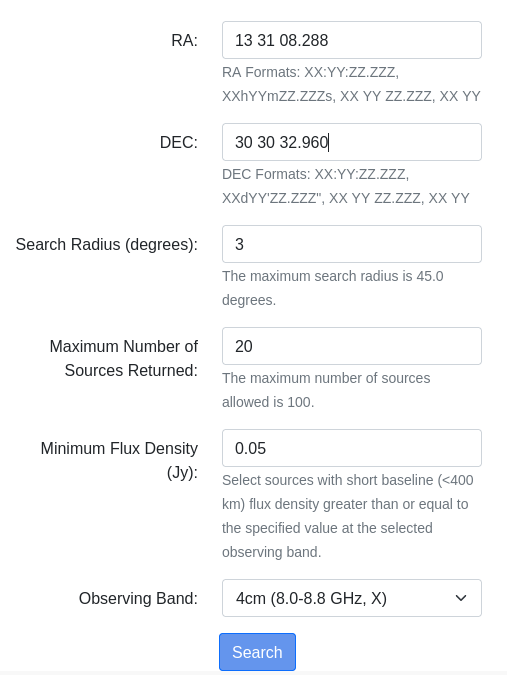
Using the new VLBA Calibrator Search Tool to limit the returned sources to those within 3 degrees of the target and with X-band flux density of at least 0.05 Jy.
[click to enlarge]
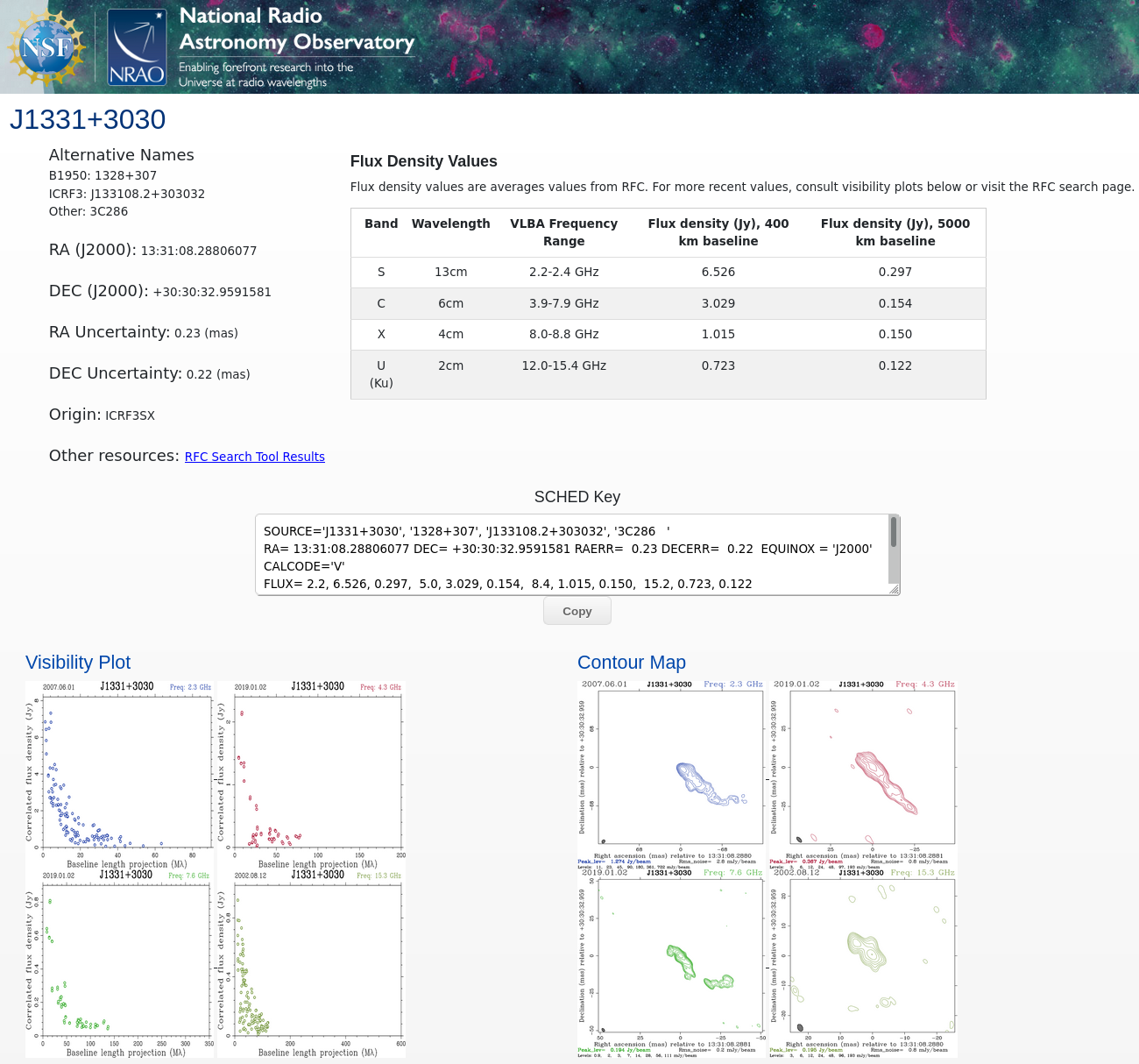
The individual source page for 3C286.
[click to enlarge]
The NRAO is pleased to announce the beta release of a new Very Long Baseline Array (VLBA) Calibrator Search Tool.
The modern interface of this new tool provides VLBA users with the information needed to plan their observations. As with the older search tool, users should enter the coordinates for their science target, set the search radius, and limit the number of returned sources. Additionally, the new tool allows users to specify a minimum flux density for the calibrators, as well as the observing band, resulting in a list of calibrators most appropriate for the planned observations. For example, a user may only be interested in phase reference calibrators that have a flux density of at least 0.05 Jy at X-band (4 cm) and located within 3 degrees of their science target.
The search results of the new tool are returned as a table of sources that meet the search parameters. Unlike the older search tool, here the table will include the flux density information for all bands available from S (13 cm) to K (1 cm). Check-boxes enable the user to select any number of sources and copy the data to their clip board, or export the data as a PDF or CSV file. The table also allows sorting by column. Below the table is a radial plot of the sources with respect to the input search coordinates. The plot is interactive and can be zoomed, panned, and downloaded as a PNG.
Clicking on a source name in the results table takes the user to a new page with more information on that specific source: full RA and Dec coordinates, all available flux density measurements, complete SCHED entry, as well as currently available visibility plots and contour maps. In addition, there is a link to a Radio Fundamental Catalog (RFC) search based on that source’s coordinates. This allows users to easily access the RFC time series data and FITS files associated with each source.
NRAO encourages all Very Long Baseline Interferometry (VLBI) users to try the new VLBA Calibrator Search Tool and provide any feedback they may have via the NRAO Helpdesk using the Department for “VLBA Calibrator Search Tool Feedback”.
NRAO is grateful to L. Petrov for permitting the use of images and flux density measurements from the RFC in the new VLBA Calibrator Search Tool.
From the Archives
Ellen Bouton

[click to enlarge]
About this month's photo: The 2006 Green Bank summer students pose on one of the site's diesel vehicles in front of the Green Bank Telescope. Left to right: Emily Martin, Kushal Mehta, Kristen Thomas, A.J. Heroux, T.J. Weadon. Not in photo: Manasseh Obi.
For over six decades, NRAO has welcomed summer students to our sites to work on a wide variety of research projects with NRAO staff mentors. Our incoming 2022 class of 37 students will participate in a rich and unique research and professional development experience. The program kicks off with the "Radio Astronomy Bootcamp," a week-long workshop in Green Bank with lectures and hands-on observing. Students will then work on their research in Green Bank, Charlottesville, and Socorro under the supervision of their mentors. Since its inception in 1959, the summer student program has engaged over 1,300 young people in scientific research, and many NRAO summer students have gone on to distinguished careers in astronomy and other physical sciences.
From the Archives is an ongoing series illustrating NRAO and U.S. radio astronomy history via images selected from our collections of individuals' and institutional papers. If readers have images they believe would be of interest to the Archives, please contact Ellen Bouton.

